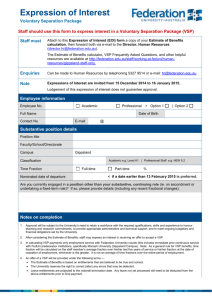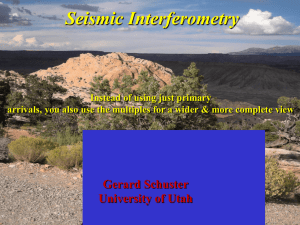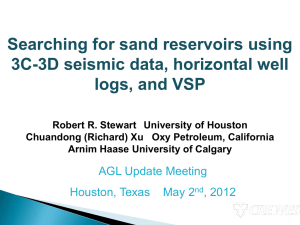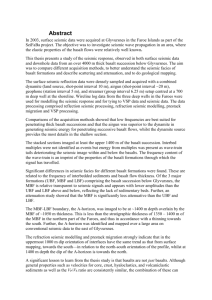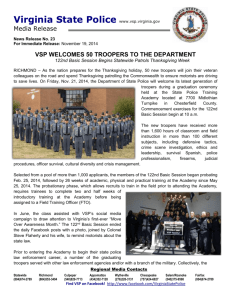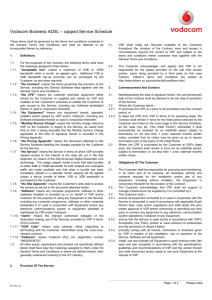christie lopra - Badley Earth Sciences
advertisement
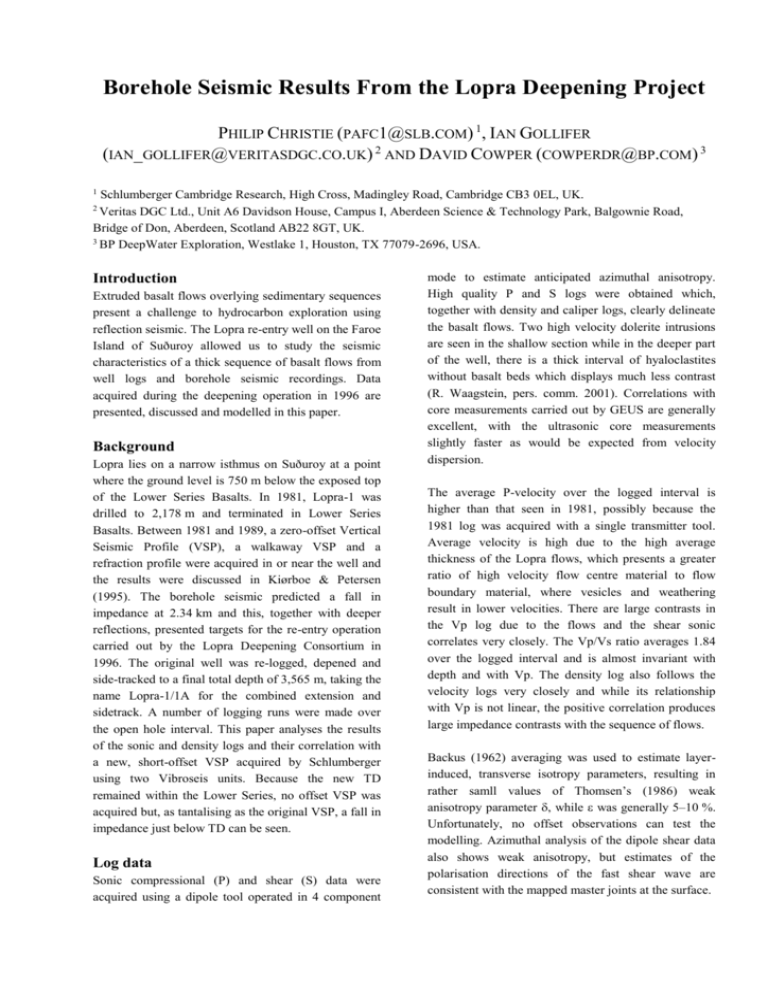
Borehole Seismic Results From the Lopra Deepening Project PHILIP CHRISTIE (PAFC1@SLB.COM) 1, IAN GOLLIFER (IAN_GOLLIFER@VERITASDGC.CO.UK) 2 AND DAVID COWPER (COWPERDR@BP.COM) 3 1 Schlumberger Cambridge Research, High Cross, Madingley Road, Cambridge CB3 0EL, UK. Veritas DGC Ltd., Unit A6 Davidson House, Campus I, Aberdeen Science & Technology Park, Balgownie Road, Bridge of Don, Aberdeen, Scotland AB22 8GT, UK. 3 BP DeepWater Exploration, Westlake 1, Houston, TX 77079-2696, USA. 2 Introduction Extruded basalt flows overlying sedimentary sequences present a challenge to hydrocarbon exploration using reflection seismic. The Lopra re-entry well on the Faroe Island of Suðuroy allowed us to study the seismic characteristics of a thick sequence of basalt flows from well logs and borehole seismic recordings. Data acquired during the deepening operation in 1996 are presented, discussed and modelled in this paper. Background Lopra lies on a narrow isthmus on Suðuroy at a point where the ground level is 750 m below the exposed top of the Lower Series Basalts. In 1981, Lopra-1 was drilled to 2,178 m and terminated in Lower Series Basalts. Between 1981 and 1989, a zero-offset Vertical Seismic Profile (VSP), a walkaway VSP and a refraction profile were acquired in or near the well and the results were discussed in Kiørboe & Petersen (1995). The borehole seismic predicted a fall in impedance at 2.34 km and this, together with deeper reflections, presented targets for the re-entry operation carried out by the Lopra Deepening Consortium in 1996. The original well was re-logged, depened and side-tracked to a final total depth of 3,565 m, taking the name Lopra-1/1A for the combined extension and sidetrack. A number of logging runs were made over the open hole interval. This paper analyses the results of the sonic and density logs and their correlation with a new, short-offset VSP acquired by Schlumberger using two Vibroseis units. Because the new TD remained within the Lower Series, no offset VSP was acquired but, as tantalising as the original VSP, a fall in impedance just below TD can be seen. Log data Sonic compressional (P) and shear (S) data were acquired using a dipole tool operated in 4 component mode to estimate anticipated azimuthal anisotropy. High quality P and S logs were obtained which, together with density and caliper logs, clearly delineate the basalt flows. Two high velocity dolerite intrusions are seen in the shallow section while in the deeper part of the well, there is a thick interval of hyaloclastites without basalt beds which displays much less contrast (R. Waagstein, pers. comm. 2001). Correlations with core measurements carried out by GEUS are generally excellent, with the ultrasonic core measurements slightly faster as would be expected from velocity dispersion. The average P-velocity over the logged interval is higher than that seen in 1981, possibly because the 1981 log was acquired with a single transmitter tool. Average velocity is high due to the high average thickness of the Lopra flows, which presents a greater ratio of high velocity flow centre material to flow boundary material, where vesicles and weathering result in lower velocities. There are large contrasts in the Vp log due to the flows and the shear sonic correlates very closely. The Vp/Vs ratio averages 1.84 over the logged interval and is almost invariant with depth and with Vp. The density log also follows the velocity logs very closely and while its relationship with Vp is not linear, the positive correlation produces large impedance contrasts with the sequence of flows. Backus (1962) averaging was used to estimate layerinduced, transverse isotropy parameters, resulting in rather samll values of Thomsen’s (1986) weak anisotropy parameter , while was generally 5–10 %. Unfortunately, no offset observations can test the modelling. Azimuthal analysis of the dipole shear data also shows weak anisotropy, but estimates of the polarisation directions of the fast shear wave are consistent with the mapped master joints at the surface. VSP data The VSP was acquired over the both the open and cased hole sections of the well, up to the point where lack of cement meant that the unsupported casing was affecting the waveforms. The raw data show welldefined P arrivals, reflected P events, downgoing direct and mode-converted shear events. The average Vp/Vs ratio was estimated from the VSP at 1.8. The reflected wavefield was waveshaped to zero phase and correlated with a synthetic seismogram after using the VSP arrival times to correct the sonic interval times. Apart from some negative drift over the shallow section (sonic slower than VSP), possibly due to casing interference, there is a steady positive drift of about 3.4% in slowness and may be attributed to velocity dispersion. The synthetic seismogram provides a confident tie with the VSP, with the majority of events correlating well, suggesting that the lateral persistence of the flows is good over the dimension of the VSP Fresnel zone. The pre-drill decrease in impedance at 2,340 m was found to be a combination of events within the basalt sequence drilled at 2,401 m. A deeper target at 1,350 ms on the earlier VSP probably correlates with a dipping bed on the present VSP at 1,328 ms. Although a further strong fall in impedance is interpreted at 3,732 m, or 167 m below the new TD, this is unlikely to be basement and is probably another event within the basalt sequence. “effective Q” of 35 in the thick interval of the basalt flows. Modelling a walkaway VSP geometry in a model of the logged basalt flows over an underlying half-space of sand, shows some hope for mode converted propagation over a limited offset range, at least for this particular model. Conclusions Reflection seismic data are difficult to process in basalt covered areas. The Lopra borehole dataset offers some insight into the seismic properties of basalts which may be of benefit in designing and processing reflection surveys. An immediate result is that “basalt”, in seismic terms, cannot be represented by a uniform slab of hard rock a couple of kilometres thick. On the positive side, intrinsic attenuation is low and propagation has been demonstrated through 3,533m of basalt flows and hyaloclastites. Coherent reflections have been tied from the VSP to the synthetic seismogram with confidence and another event below TD has been prognosed. Modelled offset VSP propagation gives some hope for mode conversions, though with a limited offset range. Less encouraging is the geometrical spreading, scattering losses, multiple development and spectral colouring which point towards low frequencies as the best hope for imaging beneath basalts. This observation has been reported several times in the literature. However, this paper may allow some more specific numbers to be applied to the basaltic flows in the Faeroese area. Attenuation estimates The VSP first arrivals, after removal of the reflected wavefield, were used to estimate attenuation. At the deepest VSP level of 3,510 m the bandwidth is about 10–45 Hz. Short-offset geometrical spreading and raytraced transmission losses were modelled, with the latter being highly sensitive to the log sampling. Simple spectral ratio estimates show no clear evidence for frequency-dependent loss. While wide-band, full-elastic modelling in a 1D medium shows colouring of the transmitted spectrum, it also supports the assertion that observed amplitude loss can be accounted for by a combination of scattering loss and geometrical spreading. The amplitude loss could be explained by an References Backus, G.E., 1962, Long-wave elastic anisotropy in transversely isotropic media, Geophysics, 44, 896– 917. Kiørboe, L. & Petersen, S.A., 1995, Seismic investigation of the Faroe basalts and their substratum, In: Scrutton, R.A., Stoker, M.S., Shimmield, G.B. & Tudhope, A.W. (eds): The tectonics, sedimentation and palaeoceanography of the North Atlantic region, Geological Society, London, Special Publications 90, 111–123. Thomsen, L., 1986, Weak elastic anisotropy, Geophysics, 51, 1954–1966.

